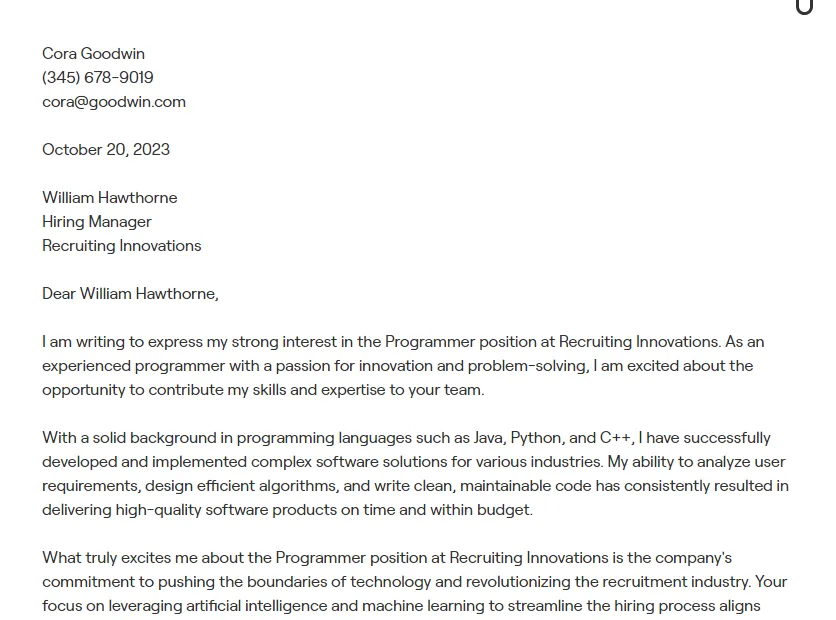What is a Programmer Cover Letter
A programmer cover letter is a crucial document that accompanies your resume when applying for programming jobs. It serves as your introduction to the hiring manager, providing context and highlighting your most relevant skills and experiences. Unlike a resume, which offers a factual summary of your qualifications, a cover letter allows you to express your personality, enthusiasm, and explain why you are a good fit for the specific role and company. It provides an opportunity to elaborate on your key achievements, demonstrate your passion for programming, and showcase your unique value proposition. Therefore, a well-crafted cover letter is essential for making a strong first impression and increasing your chances of getting an interview.
Why You Need a Strong Cover Letter
In a competitive job market, a strong cover letter can set you apart from other applicants. It allows you to personalize your application and connect with the hiring manager on a deeper level. Recruiters and hiring managers often spend very little time initially reviewing each application, so a compelling cover letter grabs their attention immediately. It allows you to showcase your enthusiasm for the specific role, demonstrate your understanding of the company’s needs, and illustrate how your skills align with their requirements. A well-written cover letter demonstrates your communication skills, attention to detail, and professionalism, all of which are highly valued in the programming field. Without a strong cover letter, your resume may be overlooked, even if you possess the necessary qualifications.
Key Components of a Winning Programmer Cover Letter
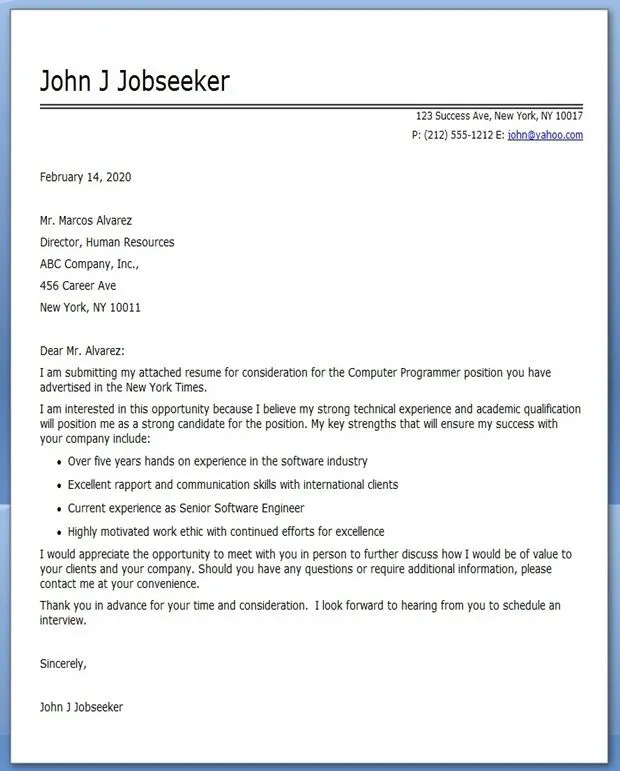
Crafting a winning programmer cover letter involves several key components that work together to create a persuasive and impactful document. From the contact information to the closing, each section plays a vital role in conveying your qualifications and securing an interview. Understanding these core elements will help you create a cover letter that grabs attention and helps you stand out. The structure should be logical, the tone should be professional, and the content should be tailored to the specific job you are applying for.
Contact Information and Salutation
Begin your cover letter with your contact information, including your name, phone number, email address, and LinkedIn profile URL (if applicable). Then, address the hiring manager by name if possible. Researching the name of the hiring manager shows initiative. If you can’t find a specific name, use a professional salutation like “Dear Hiring Manager.” This personal touch shows that you’ve put effort into the application. Ensure your contact details are easily visible and accurate to allow the recruiter to quickly reach you.
Opening Paragraph
The opening paragraph is your first opportunity to capture the hiring manager’s attention. Clearly state the position you are applying for and where you found the job posting. Immediately express your enthusiasm for the role and the company. Briefly mention one or two key skills or experiences that make you a strong candidate. The goal is to create a compelling introduction that encourages the reader to continue reading and learn more about your qualifications. Avoid generic openings; instead, personalize the paragraph to reflect your genuine interest in the specific opportunity.
Highlighting Your Skills and Experience
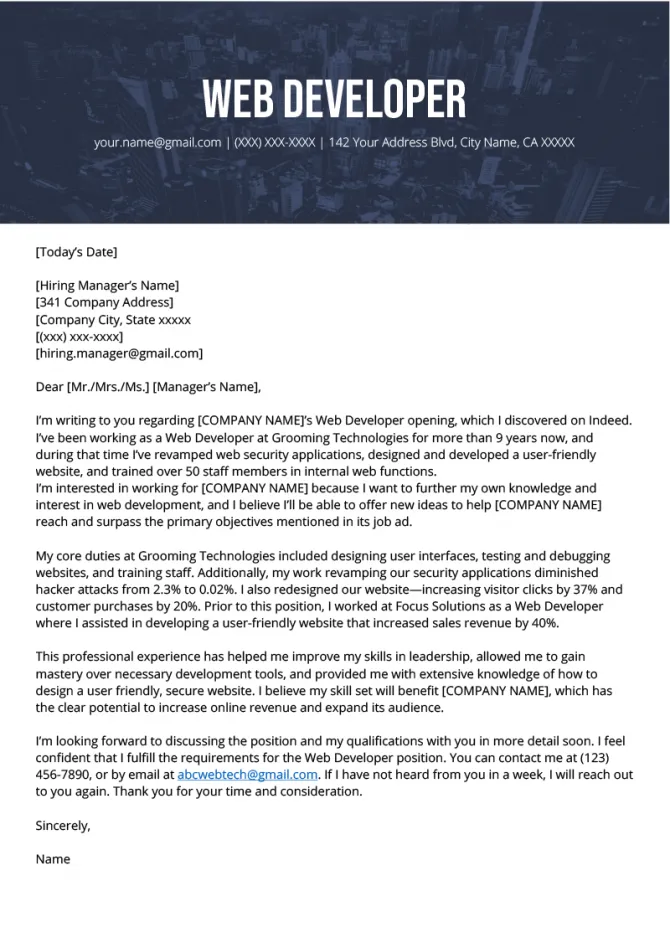
This is the heart of your cover letter, where you showcase your relevant skills and experience. Focus on the skills and experiences mentioned in the job description. Provide specific examples of how you have successfully applied these skills in previous projects or roles. Use action verbs to describe your accomplishments and quantify your achievements whenever possible. Tailor this section to each job application, ensuring your qualifications align with the company’s needs. This section should highlight your ability to solve problems, collaborate, and deliver results.
Quantify Your Achievements
Whenever possible, quantify your achievements to demonstrate the impact you’ve made in previous roles. Instead of saying “Improved code efficiency,” say “Improved code efficiency by 20%, resulting in faster processing times.” Use numbers, percentages, and data to illustrate the results of your work. This provides concrete evidence of your abilities and makes your achievements more impactful. Quantifying your achievements proves that you understand the importance of performance metrics and results-oriented work.
Showcasing Technical Skills
Clearly list your technical skills, including programming languages, frameworks, and tools you are proficient in. Go beyond simply listing these skills; provide brief examples of how you have used them in your work. For instance, if you are proficient in Python, describe a project where you utilized Python to solve a specific problem or develop a particular application. Emphasize the skills that align with the job requirements. Be specific and provide enough detail to give the hiring manager a clear understanding of your capabilities.
Demonstrating Soft Skills

While technical skills are essential, soft skills are equally important in the programming field. Highlight your communication, teamwork, problem-solving, and adaptability skills. Provide examples of how you have collaborated with others, resolved conflicts, or adapted to new technologies or challenges. Showcase your ability to learn quickly, work effectively in a team, and communicate technical concepts clearly. Soft skills often influence how effectively you can contribute to a team and adapt to new situations.
Expressing Enthusiasm and Fit
In this section, demonstrate your genuine enthusiasm for the role and the company. Explain why you are excited about the opportunity and what you admire about the company’s mission, values, or products. Research the company and role to show that you understand its needs and can contribute to its success. Highlight what attracted you to the position. By demonstrating your excitement, you show the hiring manager that you are more than just a qualified candidate – you are also a passionate individual.
Call to Action and Closing
Conclude your cover letter with a clear call to action, such as expressing your availability for an interview or inviting the hiring manager to contact you with questions. Thank the hiring manager for their time and consideration. Reiterate your interest in the position and express your confidence in your ability to contribute to the team. Keep the tone professional and positive. A strong closing leaves a lasting impression and encourages the hiring manager to move forward with your application.
Formatting and Design Tips

The formatting and design of your cover letter are crucial for creating a positive first impression. A well-formatted cover letter is easy to read and visually appealing. It shows that you pay attention to detail and take pride in your work. Proper formatting increases the likelihood that the hiring manager will read and understand your qualifications.
Choosing the Right Font and Font Size
Select a professional and readable font, such as Arial, Calibri, or Times New Roman. Ensure the font size is between 10 and 12 points for comfortable reading. Avoid using overly decorative or unusual fonts that could distract from the content. Consistency in font choice throughout the cover letter reflects professionalism. Choose a font that is easy to read on both the screen and when printed.
Formatting Your Letter for Readability
Use clear and concise language, with short paragraphs and bullet points to break up large blocks of text. Maintain consistent spacing between paragraphs and sections. Use headings and subheadings to organize the information. Proper formatting makes your cover letter easier to scan and understand. Avoid excessive use of bolding or underlining. Prioritize clarity and readability to ensure your message is conveyed effectively. Consider using a simple, clean layout.
Proofreading and Editing Your Cover Letter
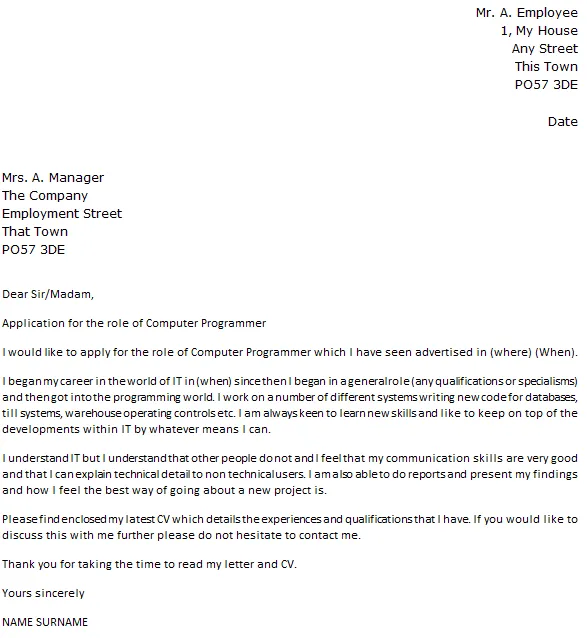
Proofread your cover letter carefully for any grammatical errors, spelling mistakes, and typos. Review the letter multiple times, and consider using grammar and spell-checking tools. Have someone else review your cover letter to catch any errors you might have missed. Errors can undermine your credibility and give the impression of a lack of attention to detail. Ensuring your cover letter is error-free demonstrates your professionalism and commitment to quality.
Examples of Effective Programmer Cover Letters
Studying examples of effective programmer cover letters can give you insights into successful formatting and content strategies. You can learn how to highlight your skills, tailor your application to specific roles, and showcase your personality. Examining diverse examples can provide inspiration and help you craft a cover letter that is unique to your skills and experiences. Analyzing effective cover letters helps you understand how to effectively communicate your qualifications to prospective employers.
Example 1 Entry-Level Programmer
This example would target a candidate with limited work experience, but strong academic skills and personal projects. The focus would be on projects, coursework, and eagerness to learn. It should highlight any relevant skills from projects or coursework. Emphasize the ability to adapt and willingness to learn. It might say: “As a recent graduate with a degree in computer science, I am eager to apply my skills.” This shows the enthusiasm and quick learning ability of a beginner programmer.
Example 2 Experienced Programmer
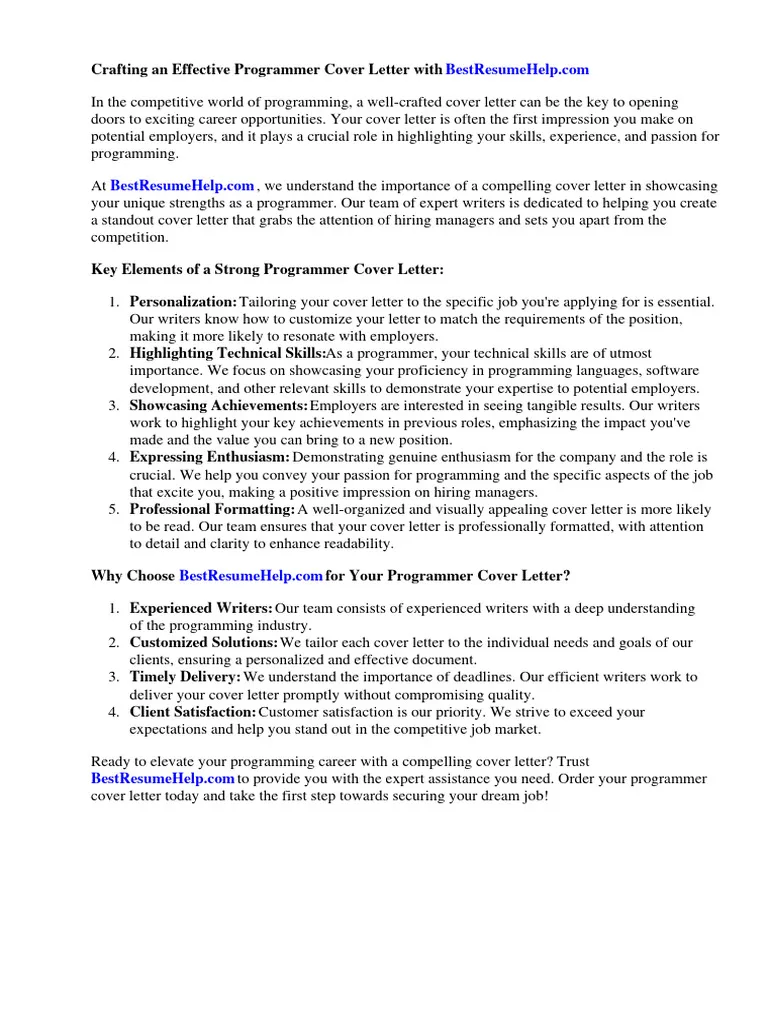
This example would suit a candidate with a significant number of years of experience. It should list accomplishments and the scope of the candidate’s previous work. The candidate needs to demonstrate a record of success. The focus should be on specific achievements and responsibilities from past roles. It might include a sentence like: “In my previous role, I reduced bugs by 15%.” This highlights the measurable impact the candidate made on their previous employer.
Example 3 Programmer with Specific Skills
This example would target candidates with specific technical skills. The focus should be on those skills. It might include languages or other specializations. It is important to provide examples where the candidate successfully applied these skills. The example will include a line that states: “I am highly proficient in Python, specifically using it to build RESTful APIs.” It should tailor the skills to the particular job description. The cover letter should be highly customized for each job application.
Tailoring Your Cover Letter for Each Job Application
Tailoring your cover letter for each job application is crucial for demonstrating your genuine interest and qualifications for the specific role. Generic cover letters are easily recognized and often discarded. Customization helps you stand out and showcases that you have researched the company and understand their needs. A well-tailored cover letter is more likely to capture the hiring manager’s attention.
Researching the Company and Role
Before you begin writing, research the company and the specific role. Visit their website, read their mission statement, and learn about their products or services. Examine the job description carefully to identify the key skills, qualifications, and experiences they are seeking. Understanding their needs will help you tailor your cover letter to address their specific requirements. Use the research to highlight the aspects of the company and the role that excite you. Make sure to use relevant keywords from the job description.
Matching Your Skills to the Job Description
Carefully review the job description and identify the skills and experiences that are most important to the role. Highlight these skills and experiences in your cover letter, providing specific examples of how you have used them in the past. Use the same keywords and phrases from the job description to make it easy for the hiring manager to see that you meet their requirements. Focus on the experiences and qualifications that align directly with the job’s responsibilities. By carefully matching your skills, you demonstrate that you are a strong fit for the position.
Addressing Specific Requirements
Address any specific requirements or qualifications mentioned in the job description. If they require experience with a particular technology or framework, be sure to highlight your experience with it. If they are looking for someone with experience in a specific industry, provide examples of your relevant projects or experiences. Show how you can contribute to the company’s goals. Addressing specific requirements shows that you have paid attention to the details of the job posting and can meet their needs.
Common Mistakes to Avoid
Avoiding common mistakes is essential for ensuring your cover letter leaves a positive impression. Careless errors can undermine your credibility and weaken your application. By taking the time to avoid these pitfalls, you can increase your chances of securing an interview and landing your dream job. Making a few simple changes can significantly improve your cover letter’s effectiveness.
- Using a generic cover letter
- Failing to tailor your letter to the job
- Making grammatical errors and typos
- Exceeding the one-page limit
- Focusing only on your needs, not the company’s
- Repeating information from your resume without adding value
- Using unprofessional language or tone
By crafting a well-written and personalized cover letter, you can make a strong first impression and increase your chances of landing your dream job. Remember to focus on your skills, quantify your achievements, and express your enthusiasm for the role. Proofread carefully and tailor your letter to each job application. Good luck with your job search!
